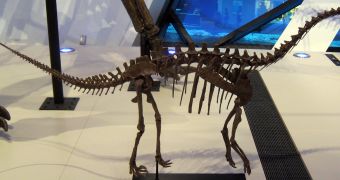Dinosaurs ruled the Earth for over 100 million years before, thankfully, bowing out to leaves us some space. But apart from being the most popular extinct animals and the source of countless Hollywood movies, they were quite a peculiar bunch of species.
One new study provides data on the distribution of size within dinosaur species as well as an explanation of why there were so many large dinosaur species.
Normally, vertebrates follow a common body size distribution. The biggest diversity is among the smaller species, there are plenty of rodent species, but only a few antelope species and very few elephant ones, for example.
The same is true throughout nature, birds, fishes, amphibians and reptiles, all follow the same pattern, many small species, few large ones.
Not so with the dinosaurs, in fact, it's quite the opposite, there are many, many large species and fewer smaller ones.
The study by researchers from the Queen Mary University of London looked at data from a variety of sources, 329 different species in total, and confirmed what other smaller studies showed, there were more large species than small ones.
There are some, exceptions, theropods, for example, the bipedal, mostly carnivorous dinosaurs that are the ancestors of birds, showed a size distribution similar to other animals, with more small species and fewer large ones.
The researchers took into account the fact that fossil data is quite obviously incomplete. Smaller skeletons tend to be less well preserved and much harder to find.
But there would have to be thousands of as-of-yet unknown small species of dinosaurs to get a size distribution comparable to other vertebrates. What's more, fossil records of mammals or even pterosaurs, which lived alongside dinosaurs, indicate a regular size distribution.
Confident that the results were accurate, the researchers tried to explain the difference between dinosaurs and all other vertebrate species.
What they realized was that it's precisely because dinosaurs are so large that is the explanation for the size discrepancy. As dinosaurs got larger and larger, egg size stopped growing along with them at one point. What this means that even huge Sauropods laid eggs only about 1 foot, 30 cm, around yet grew to tens of meters, over 100 feet in length.
Baby sauropods took a decade to reach adulthood, but continued to grow throughout the rest of their lives. The huge size difference suggests that infant dinosaurs occupied different niches in the ecosystem as they grew.
This is further supported by evidence that young dinosaurs were quite different from their adult versions, indicating they had different eating styles and even different habitats.
What this means is that the niches filled by the myriad of small species in today's animals were simply occupied by younger dinosaurs. The diversity in species is replaced by diversity in size among the same species. A modern example is the crocodile. Young crocodiles are very small, surviving on insects and tadpoles but later grow large enough to attack much larger prey.

 14 DAY TRIAL //
14 DAY TRIAL //